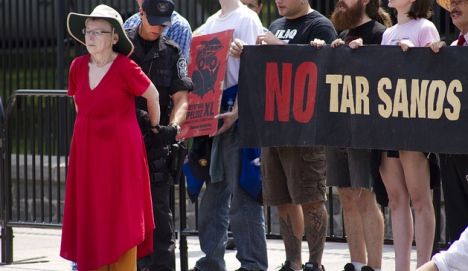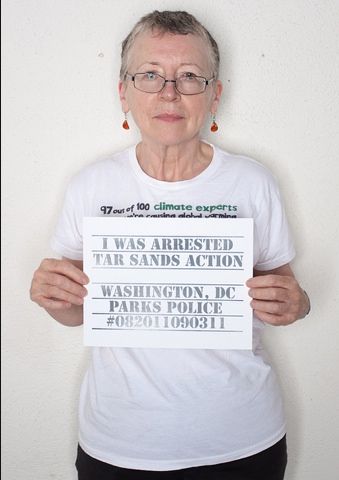Patricia Warwick is certainly a committed member of the climate justice community. Last year, she participated in the People’s Climate March in spite of a broken arm, in 2010, she braved a long bus ride to Cancun, Mexico, for COP 16, and in 2011, she risked arrest twice to demand action on the tar sands.
The first time, it was in Washington DC for the historical Tar Sands Action when hundreds of people staged sit-ins in front of the White House calling upon President Obama to reject the Keystone XL pipeline. “My friends didn’t know what I was doing until they saw me on the news,” she remembers with a chuckle, “Not until CBC news reported that a 68 year old Canadian woman was arrested at the White House.” The second time, it was closer to home — when hundreds risked arrest at Parliament Hill in Ottawa to demand an end to tar sands expansion.
Now, Patricia’s planning to make another trip to Ottawa for the Climate Welcome action at 24 Sussex Drive. She fears that this government, just like the past one, is “under the thumb of the oil industry.” However, she also knows that there’s nothing quite as powerful as a determined group of people putting their bodies on the line to send a collective message — as someone who voted Liberal in the election, she believes that Prime Minister Trudeau has good intentions, but he won’t take action unless he’s pushed.
You might call her something of a pro when it comes to staging bold actions demanding climate justice — and she has some insights to share about what it’s like.
It was a sunny September day in Ottawa four years ago when she joined dozens of others for a sit-in on the lawns of Parliament Hill. Many of the participants weren’t prepared for the heat but had a long wait ahead of them. So Patricia’s first words of advice: dress for the weather because it’s going to be a long day.
Patricia recalls waiting quite a while even once the arrests started, with police arresting one or two participants at a time. When it was her turn, she was handcuffed and taken to an on-site police tent that was by the canal, close to Parliament Hill. At the tent, they took her picture, took her fingerprints and issued a trespassing fine for about $80 that had to be paid at a later date — much like a parking ticket. Once enough people had been processed at the tent, they were loaded onto a van, taken to Park Street, and as Patricia so casually put it, dumped off on the side of the road.
They didn’t have phones with them — or any sort of valuables because in a civil disobedience action, participants face the risk of having all items they are carrying being confiscated. So it was a bit challenging to find their friends again after they had been dropped off — but a clear pre-action briefing which had identified an a post-arrest meeting spot helped them reconvene.
At the beginning of the actions, all participants wrote out legal support phone numbers on their arm in case they needed them. “But one thing they don’t warn you,” Patricia warns “is that if you sweat, the number’s no longer legible!” This was the case for Patricia in Ottawa due to the heat and in DC, due to the nervousness of risking arrest for the first time. In November, of course, there’s less of a chance this will happen!
Patricia remembers being highly anxious at the Washington DC sit ins. At that particular action, the participants on day one were arrested and kept overnight as what she calls an “intimidation tactic.” As a participant on the second day, she wasn’t quite too sure what to expect. In the end, her batch was arrested, taken to an off site police office and released almost immediately after being processed.
We’re expecting the sit ins at 24 Sussex Drive to go down similarly to the ones in Ottawa in 2011 here’s what we expect your experience at the action to look like:
- On the day before the action, you’ll arrive in Ottawa perhaps, on a bus or carpool with other courageous and climate activists.
- You might very likely go straight to the training space right as you arrive, with just enough time to stretch your legs, pull out a snack from your bag, maybe give a call to people you are staying with if you haven’t yet, and get familiar with new faces.
- Once you arrive at the University of Ottawa, you’ll go through a comprehensive civil disobedience training, role-play how the action is likely to unfold, and hear a lawyer tell you about what risking arrest means. The information, atmosphere and adrenaline may have you tired, excited and nervous about the next day, all at once.
- The next day, we’ll gather at 9:30AM at Rideau Falls park over the water for an opening and mandatory action briefing. Afterwards, at 11:00 AM, we will pick up our signs, placards, and gifts, and start marching on the street over the bridge and onto Sussex Drive. When we reach 24 Sussex, we will cross the street and sit-in outside the fence.
- The day may go by with doses of excitement, nervousness, maybe drizzles of rain, media cameras, and a sense that we’re making something big happen.We’ll be sitting on blankets or using them to stay warm, we’ll be sitting-in for a few hours and deliver gifts.
- At the end of the day, sometime in the late afternoon, we might all be be lined up and getting arrested. We’re not sure exactly what it will look like, but we can think that it’ll look like something of what Patricia experienced.
To get an even better idea of what to expect when you’re getting arrested, we recommend watching our online webinar here, and more information about the logistics, times and locations of each day are available here.
And fortunately, you’ll be sitting in at 24 Sussex Drive with bold and courageous folks like Patricia that have quite a bit of experience with civil disobedience.


